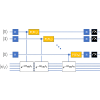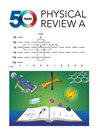量子模拟中的芝诺效应抑制量规漂移
IF 2.9
2区 物理与天体物理
Q2 Physics and Astronomy
引用次数: 0
摘要
格规理论的量子模拟是研究许多复杂问题(包括具有实时动态性的问题)的一种很有前途的工具。然而,对于量规理论来说,在时间演化过程中保持量规不变性是一项重大挑战。这类理论有一个比物理空间更大的完整希尔伯特空间--即具有规整不变性或等价遵守高斯定律的状态集。虽然从物理希尔伯特空间开始的汉密尔顿动力学的精确实现将使系统保持在物理空间内,但各种类型的误差将不可避免地产生物理空间之外的成分。本研究提出了一种通过芝诺效应抑制这种轨距漂移的方法。与芝诺效应的标准图示一样,我们的方法依赖于对物理子空间的频繁投影。此外,我们还讨论了一种降低量规漂移速度的技术,这有助于降低所需的投影频率。我们在一个 Z2 轨则理论玩具模型上演示了我们的方法。本文章由计算机程序翻译,如有差异,请以英文原文为准。

Zeno effect suppression of gauge drift in quantum simulations
Quantum simulation of lattice gauge theories is a promising tool for the study of many complicated problems including ones with real-time dynamics. For gauge theories, however, there is a major challenge in maintaining gauge invariance during time evolution. Such theories have a full Hilbert space that is larger than the physical space—the set of states which are gauge invariant or equivalently respect the Gauss law. While an exact implementation of Hamiltonian dynamics starting in the physical Hilbert space will keep the system in the physical space, various types of errors will inevitably produce components outside of it. This work proposes a method of suppressing this gauge drift via the Zeno effect. As in the standard picture of the Zeno effect, our method relies on frequent projection onto the physical subspace. Additionally, a technique is discussed to reduce the speed of the gauge drift, which helps to reduce the required frequency of projections. We demonstrate our method on a gauge theory toy model.
求助全文
通过发布文献求助,成功后即可免费获取论文全文。
去求助
来源期刊

Physical Review A
物理-光学
CiteScore
5.40
自引率
24.10%
发文量
0
审稿时长
2.2 months
期刊介绍:
Physical Review A (PRA) publishes important developments in the rapidly evolving areas of atomic, molecular, and optical (AMO) physics, quantum information, and related fundamental concepts.
PRA covers atomic, molecular, and optical physics, foundations of quantum mechanics, and quantum information, including:
-Fundamental concepts
-Quantum information
-Atomic and molecular structure and dynamics; high-precision measurement
-Atomic and molecular collisions and interactions
-Atomic and molecular processes in external fields, including interactions with strong fields and short pulses
-Matter waves and collective properties of cold atoms and molecules
-Quantum optics, physics of lasers, nonlinear optics, and classical optics
 求助内容:
求助内容: 应助结果提醒方式:
应助结果提醒方式:


